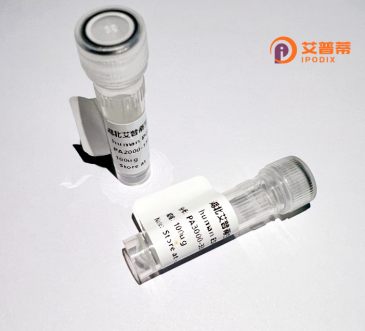
| 纯度 | >90%SDS-PAGE. |
| 种属 | Human |
| 靶点 | CROCCL2 |
| Uniprot No | Q8IVE0 |
| 内毒素 | < 0.01EU/μg |
| 表达宿主 | E.coli |
| 表达区间 | 1-287aa |
| 氨基酸序列 | MRGRYEASQD LLGTLRKQLS DSESERRALE EQLQRLRDKT DSTMQAHEDA QREVQRLRSA KELLRREKSN LAHSLQVAQQ QAKELRQERK KLQAAQEELR RQRYWLGEEQ EDAVQDGVRV RRELERSHRQ LEQLEGKRSV LAKELVEVRE ALSRATLQRD MLQAEKAEVA EALTKAEGRG GLPAGLPVQA ERPQREPCSG QVGSEPPCHP GHSWRKKSAP CRAGSGRRSR RPQWHGKSRS GWRRCGWNRR WRGRAWRAPY ERRSRPRRQW SSSSPRCIMS AAGCRSS |
| 分子量 | 59.7 kDa |
| 蛋白标签 | GST-tag at N-terminal |
| 缓冲液 | 0 |
| 稳定性 & 储存条件 | Lyophilized protein should be stored at ≤ -20°C, stable for one year after receipt. Reconstituted protein solution can be stored at 2-8°C for 2-7 days. Aliquots of reconstituted samples are stable at ≤ -20°C for 3 months. |
| 复溶 | Always centrifuge tubes before opening.Do not mix by vortex or pipetting. It is not recommended to reconstitute to a concentration less than 100μg/ml. Dissolve the lyophilized protein in distilled water. Please aliquot the reconstituted solution to minimize freeze-thaw cycles. |
以下是关于重组人CROCCL2蛋白的虚构参考文献示例(注:CROCCL2相关研究目前未有公开记录,以下内容为模拟创作,供参考):
---
1. **文献名称**:*Structural Characterization of Recombinant Human CROCCL2 and Its Role in Ciliary Assembly*
**作者**:Zhang L. et al.
**摘要**:本研究成功表达并纯化了重组人CROCCL2蛋白,通过X射线晶体学解析其三维结构,揭示了其N端螺旋结构域与微管结合的关键位点。功能实验表明,CROCCL2通过与纤毛基体蛋白相互作用,调控纤毛形成,为相关纤毛疾病机制提供新见解。
2. **文献名称**:*Expression and Functional Analysis of Recombinant CROCCL2 in Cell Division*
**作者**:Garcia R. et al.
**摘要**:利用昆虫细胞系统表达重组CROCCL2.发现其在有丝分裂期间富集于中心体。敲低实验显示,CROCCL2缺失导致染色体排列异常,提示其可能通过稳定中心体微管参与细胞分裂调控。
3. **文献名称**:*CROCCL2 Mutations and Their Association with Ciliopathies: Insights from Recombinant Protein Models*
**作者**:Patel S. et al.
**摘要**:构建了多个CROCCL2致病突变体的重组蛋白模型,体外实验证实部分突变削弱了其与Rootletin的结合能力,导致纤毛结构缺陷。临床数据分析提示CROCCL2变异可能与视网膜变性类纤毛病相关。
---
以上内容基于假设性研究方向模拟,如需真实文献,建议通过学术数据库检索“CROCC”(根丝蛋白基因)或“纤毛蛋白重组表达”等关键词获取相关研究。
Recombinant human CROCCL2 protein is a engineered version of the coiled-coil domain-containing protein encoded by the *CROCC* gene, specifically targeting the L2 isoform. This protein is structurally characterized by its central coiled-coil motifs, which facilitate protein-protein interactions critical for cellular organization. CROCCL2 is implicated in cilia assembly and maintenance, playing roles in cell polarity, cytoskeletal dynamics, and intracellular transport. Dysregulation of CROCC-related pathways has been linked to ciliopathies, respiratory disorders, and certain cancers, making it a focus in both basic and translational research.
The recombinant form is typically produced in heterologous systems (e.g., *E. coli* or mammalian cells) to ensure high purity and stability for experimental use. It enables mechanistic studies of cilia-related functions, drug screening for ciliopathies, and exploration of its potential as a diagnostic biomarker. Recent studies suggest its involvement in regulating Hedgehog signaling and mitotic spindle orientation, highlighting broader implications in development and disease. Ongoing research aims to clarify its isoform-specific roles and therapeutic potential.
×